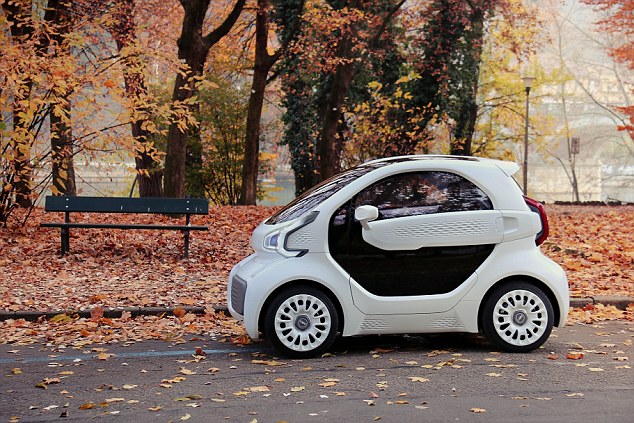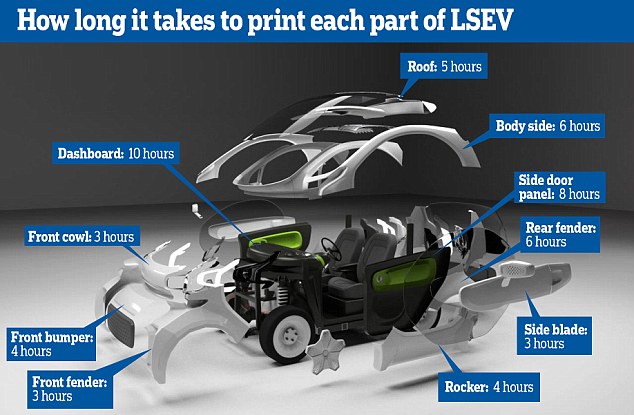nivek
As Above So Below
The sleek electric car that's 3D PRINTED and takes just THREE DAYS to make (and you can drive one home for £7,500)

A revolutionary electric car made using a 3D printer has been unveiled and is due to start selling next year in Asia and Europe. The two-seater, called LSEV, takes just three days to make, according to the car's manufacturer.
Now the car maker is assembling a production line for the sleek vehicle which is expected to hit the market in April 2019 at a price of €8,500 (£7,525).

LSEV is 1.5m (4.9ft) high, 2.5m (8.3ft) long and 1.3m (4.3ft) wide - about the size of a Smart car.
With a weight of 450kg (992 pounds), it has a top speed of 70kmh (43 mph) and can travel 150km (93 miles) once fully charged.
The car is the brainchild of XEV Limited, a start-up firm from Hong Kong which has a design centre in Italy and production bases in China.
Lou Tik, the founder of XEV Limited, told MailOnline that the majority of the car was 3D-printed with three types of material: enhanced nylon, polylactic acid - a common 3D printing filament - and rubber-like TPU.
All metal parts of the car, such as the chassis and the engine, use the traditional production methods.
A team of around 50 people at XEV designed the car from scratch, developed special 3D printers for it and have produced one prototype. Six more cars would be produced before the end of July, according to Mr Lou.
The Hong Kong-native started on the project two years ago with his Italian co-founder and 3D printing director, Robert Moretti. The project had an initial £1.7 million (€2million) funding after winning Horizon 2020, EU's biggest programme for research and innovation.
From the very beginning, the team's goal was to make a 3D-printed car that could be sold on the mass market.

- The cutting-edge car is expected to be sold in Asia and Europe from next year
- The two-seater is about the size of a Smart, but is said to be five times stronger
- It boasts a top speed of 70kmh and can travel 150km once fully charged
- 3D printing would bring significant changes to car industry, said the carmaker

A revolutionary electric car made using a 3D printer has been unveiled and is due to start selling next year in Asia and Europe. The two-seater, called LSEV, takes just three days to make, according to the car's manufacturer.
Now the car maker is assembling a production line for the sleek vehicle which is expected to hit the market in April 2019 at a price of €8,500 (£7,525).

LSEV is 1.5m (4.9ft) high, 2.5m (8.3ft) long and 1.3m (4.3ft) wide - about the size of a Smart car.
With a weight of 450kg (992 pounds), it has a top speed of 70kmh (43 mph) and can travel 150km (93 miles) once fully charged.
The car is the brainchild of XEV Limited, a start-up firm from Hong Kong which has a design centre in Italy and production bases in China.
Lou Tik, the founder of XEV Limited, told MailOnline that the majority of the car was 3D-printed with three types of material: enhanced nylon, polylactic acid - a common 3D printing filament - and rubber-like TPU.
All metal parts of the car, such as the chassis and the engine, use the traditional production methods.
A team of around 50 people at XEV designed the car from scratch, developed special 3D printers for it and have produced one prototype. Six more cars would be produced before the end of July, according to Mr Lou.
The Hong Kong-native started on the project two years ago with his Italian co-founder and 3D printing director, Robert Moretti. The project had an initial £1.7 million (€2million) funding after winning Horizon 2020, EU's biggest programme for research and innovation.
From the very beginning, the team's goal was to make a 3D-printed car that could be sold on the mass market.

